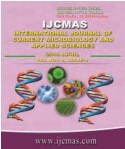


 National Academy of Agricultural Sciences (NAAS)
National Academy of Agricultural Sciences (NAAS)

|
PRINT ISSN : 2319-7692
Online ISSN : 2319-7706 Issues : 12 per year Publisher : Excellent Publishers Email : editorijcmas@gmail.com / submit@ijcmas.com Editor-in-chief: Dr.M.Prakash Index Copernicus ICV 2018: 95.39 NAAS RATING 2020: 5.38 |
Hydraulic properties of soils play a significant role in development and adoption of suitable water management practices capable of increasing input use efficiency of soils for maintaining agricultural production of arid and semi arid regions. The study was carried out to investigate the hydraulic properties of soils varying in texture, organic carbon and salt contents. The soil samples were collected from 0-15 and 15-30 cm depths at farmers’ field in different villages spread over nine districts of the Haryana state during 2016-17. The experimental soils were found to belong to six textural classes i.e., sand, loamy sand, sandy loam, loam, silty loam and sandy clay loam having silt + clay content from 6- 40 %. The organic carbon (OC) content, electrical conductivity, pH, saturated hydraulic conductivity (Ksat), sodium adsorption ratio, moisture at field capacity and permanent wilting point soils were determined using standard methods. The Ksat of the soils was found of to be significantly and exponentially positively correlated with bulk density (R2 = 0.61) and negatively correlated with silt+clay content (R2 = 0.90) at 0-15 and 15-30 cm depths. The Ksat had significant and exponential negative correlation with soil OC at 0-15 cm (R2 = 0.83) and 15-30 cm (R2 =0.66) in the present study. The soil moisture at field capacity (FC) and permanent wilting point (PWP) were observed positively correlated with silt+clay content with R2 value of 0.87 and 0.85, respectively. The moisture at FC and PWP were found to be significantly and positively correlated with soil organic carbon content with R2 = 0.85 and 0.76, respectively, at 0-15 cm depth. However, moistures at FC and PWP showed significant and negative correlation with bulk density at both the depths. Maximum water holding capacity of soils was observed higher with increase in silt+clay content and lower with increase in bulk density at both the depths. The pH1:2 and EC1:2 of the soils were found in range of 6.69 - 8.08 and 0.11-3.68 dS/m, respectively. However, no significant correlation was observed between hydraulic properties and soluble salt concentration. The results of the study and relationship of hydraulic properties with the physical properties of the soils indicated that knowledge of hydraulic properties of the soils is pre-requisite for adopting efficient water management practices in arid and semi-arid regions of the Haryana state for maintaining the sustainable crop production.
 |
 |
 |
 |
 |